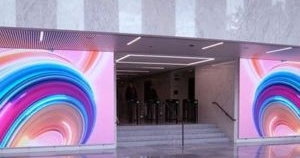After bursting onto the scene a few decades ago, large-format LCD technology has come a long way. Manufacturers made remarkable strides in improving the performance of their displays as LCD technology became more prevalent in domestic and commercial environments. LCD display technology was an advancement from more dated technologies, and the marked difference in picture quality led to a transformation of the industry. This surge in popularity and applicability came at a cost, but not for customers. Knowing that more and more businesses needed LCD display technology to keep up with their competitors, LCD manufacturers reached a point where they focused on lowering prices to sell the most displays rather than improving quality to sell the best displays. By racing their competitors to the bottom and focusing almost exclusively on cost at the expense of functionality, LCD manufacturers misjudged the direction of the display industry, and the evolutionary patterns of technology at large.
The technology of all kinds is always going to improve, but by prioritizing cost over quality, LCD manufacturers left the inevitable technological improvements to others. You wouldn’t buy a first-generation Android phone right now even if it were a quarter the price of an iPhone 8. Why? Because in the long term price isn’t the most important factor in a purchasing decision. By prioritizing price, LCD manufacturers let fall by the wayside many of the reasons their technology was worth buying in the first place. This opened the door for LED displays to take over the display industry just as LCD displays once did. LCD displays have traditionally had two primary advantages over their LED rivals. First, LCD’s have typically had sharper resolutions and better up-close viewing quality. Second, LCD’s have been cheaper.
Racing to the bottom has left both of those advantages in serious jeopardy. Over time, while LCD manufacturers jostled to cut costs, LED manufacturers dedicated serious resources to improving their resolution and picture quality to the point where they now are competitive with their LCD rivals. Furthermore, many of these LED displays also come with a lower total cost of ownership, since they are built with higher performing and more durable materials, materials that increase upfront cost. Loathe to do anything to raise their sticker prices, LCD manufacturers took far too short a view. LED Manufacturers should take note, not just for the sake of their companies, but for the sake of their industry. To learn how Nanolumens prioritizes performance over price, click here.

